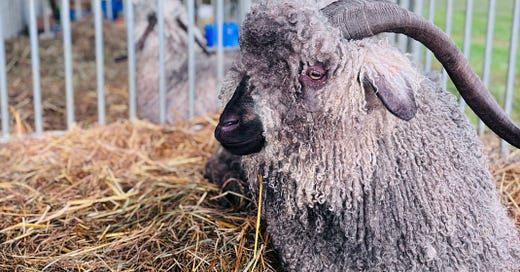Angora goats have a 320-degree field of vision. (Photo by Laura Portwood-Stacer)
Tell a story about the most interesting thing you’ve encountered while doing the research for your book (or whatever project you’re working on right now). Your story might be about an ethnographic encounter, an archival document, a text you’ve closely analyzed, or some other kind of data that you’ve gathered. Imagine you’re relating your story to someone who isn’t familiar with your research yet.
After telling your story, try to articulate why this story was the one that came to mind when you were prompted to come up with the “most interesting thing” you’ve encountered. What makes it the most interesting, in light of all the research you’ve done and in light of your knowledge of the scholarly literature on your topic?
The purpose of this prompt is to connect with what is really driving you to share your research findings with the world. You’ve spent years immersed in your original research and the scholarly literature. Given all that you know at this point, you have special insight into each ethnographic episode, archival text, or piece of data that you’ve encountered. You know why it matters in a way that no one else does yet, because no one else has the exact same combination of experience and theoretical exploration that you are bringing to your topic.
The second part of the prompt (“why is this the most interesting story to tell?”) is intended to help you recognize and value your original point of view so that you can communicate it to others who may need to know why your research is vital and worthy of publication.
If you’re able to talk about your research topic in an interesting way and explain why yourself and others should find your topic interesting, you’ll set yourself up for success with book publishers and any other parties that you’ll need to rally in support of your scholarship, such as employers, grant funders, and others.
I specialize in helping academics write outstanding book proposals for scholarly presses, so I’m always thinking about how writers can learn to better communicate with publishers. To get free book publishing tips and announcements of upcoming programs, subscribe to my Manuscript Works newsletter.
Laura Portwood-Stacer, founder of Manuscript Works
For more scholarly writing inspiration, check out these resources from the curators of #AcWriMoments:
ScholarShape by Margy Thomas
WriteSPACE by Helen Sword









Everything is so interesting that it's hard to choose just one most interesting thing! But I have a vivid memory of the moment I realized that Story-Argument is everywhere. That it's not just a pattern in scholarship or written texts, but also a pattern in built environments, communities, religions and schools of thought, and in life itself.
The memory is from May 2019, a rainy day in Rome with my friends. All morning as we'd woven through the streets taking in the sights, I kept having this powerful feeling of deja vu. I knew logically that I'd never been to Rome before but kept feeling that I had. The shades of gray and green, the smell of the air, the flow of the streets, and even the way the raindrops slid over the ancient sculptures all felt so eerily familiar.
And then, around mid-day, we rounded a corner and in front of us was the Pantheon. It's a massive temple-turned-basilica that has stood for almost two millennia and been in continuous use its entire life, reinterpreted by successive generations. I felt this physical sensation like sometimes happens in ancient or sacred places, where the building itself draws you toward it. Inside, standing in the rotunda on the marble floor that had been set in place almost 2,000 years before, looking up at the sky through the open oculus, I lifted my arm and felt the raindrops falling into my hand.
That was the moment when I went from "knowing" Story-Argument as a useful academic idea to *feeling* it as a deep structure for meaning-making. The Pantheon was a Story-Argument, Rome was a Story-Argument, the whole world was a Story-Argument. And if we, collectively, could come to better understand these deep patterns tying everything together, maybe new kinds of conversations and collaborations would be possible.
This revelation didn't publicly shift my work right away, but in the years since, it has quietly changed everything. I still help scholars develop scholarship, but the meaning of that work is much more expansive now. And gradually, the deep internal shift that started all those years ago in Rome is beginning to reveal itself in ScholarShape's outer layers.
Whew! Great prompt, Laura. Thanks for drawing out these memories with your questions!
I’m about to launch a fundraising campaign for a cause I care about deeply; this lovely prompt from Laura Portwood-Stacer helped me think about what story (and whose) to focus on for each of several potential audiences. What’s The Most Interesting Thing? How can I make this the GOAT fundraiser?! (Thanks Laura and Michelle!)